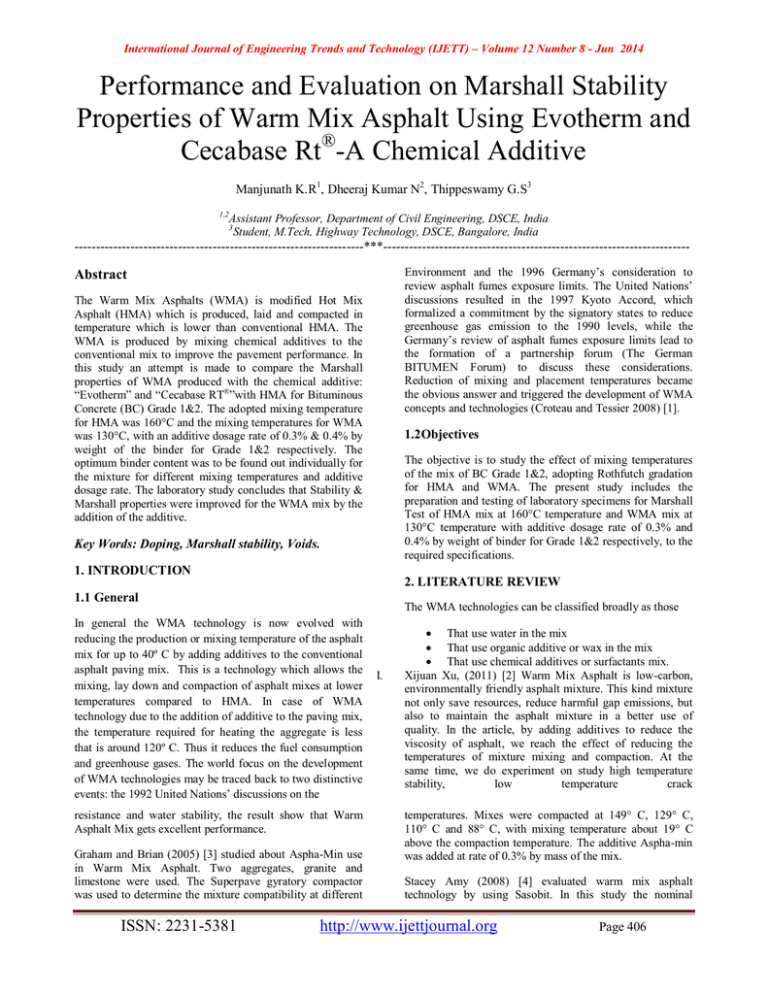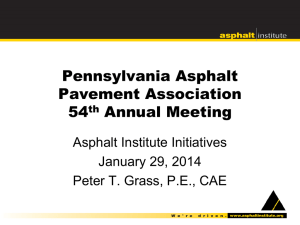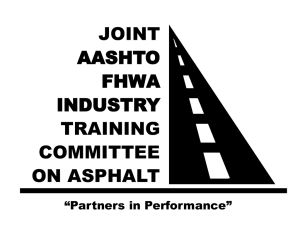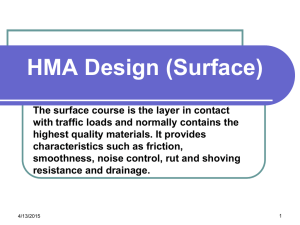Performance and Evaluation on Marshall Stability Cecabase Rt
advertisement

International Journal of Engineering Trends and Technology (IJETT) – Volume 12 Number 8 - Jun 2014 Performance and Evaluation on Marshall Stability Properties of Warm Mix Asphalt Using Evotherm and Cecabase Rt®-A Chemical Additive Manjunath K.R1, Dheeraj Kumar N2, Thippeswamy G.S3 1,2 Assistant Professor, Department of Civil Engineering, DSCE, India 3 Student, M.Tech, Highway Technology, DSCE, Bangalore, India -------------------------------------------------------------------***----------------------------------------------------------------------Environment and the 1996 Germany’s consideration to review asphalt fumes exposure limits. The United Nations’ discussions resulted in the 1997 Kyoto Accord, which formalized a commitment by the signatory states to reduce greenhouse gas emission to the 1990 levels, while the Germany’s review of asphalt fumes exposure limits lead to the formation of a partnership forum (The German BITUMEN Forum) to discuss these considerations. Reduction of mixing and placement temperatures became the obvious answer and triggered the development of WMA concepts and technologies (Croteau and Tessier 2008) [1]. Abstract The Warm Mix Asphalts (WMA) is modified Hot Mix Asphalt (HMA) which is produced, laid and compacted in temperature which is lower than conventional HMA. The WMA is produced by mixing chemical additives to the conventional mix to improve the pavement performance. In this study an attempt is made to compare the Marshall properties of WMA produced with the chemical additive: “Evotherm” and “Cecabase RT®”with HMA for Bituminous Concrete (BC) Grade 1&2. The adopted mixing temperature for HMA was 160°C and the mixing temperatures for WMA was 130°C, with an additive dosage rate of 0.3% & 0.4% by weight of the binder for Grade 1&2 respectively. The optimum binder content was to be found out individually for the mixture for different mixing temperatures and additive dosage rate. The laboratory study concludes that Stability & Marshall properties were improved for the WMA mix by the addition of the additive. 1.2Objectives The objective is to study the effect of mixing temperatures of the mix of BC Grade 1&2, adopting Rothfutch gradation for HMA and WMA. The present study includes the preparation and testing of laboratory specimens for Marshall Test of HMA mix at 160°C temperature and WMA mix at 130°C temperature with additive dosage rate of 0.3% and 0.4% by weight of binder for Grade 1&2 respectively, to the required specifications. Key Words: Doping, Marshall stability, Voids. 1. INTRODUCTION 2. LITERATURE REVIEW 1.1 General The WMA technologies can be classified broadly as those In general the WMA technology is now evolved with reducing the production or mixing temperature of the asphalt mix for up to 40º C by adding additives to the conventional asphalt paving mix. This is a technology which allows the mixing, lay down and compaction of asphalt mixes at lower temperatures compared to HMA. In case of WMA technology due to the addition of additive to the paving mix, the temperature required for heating the aggregate is less that is around 120º C. Thus it reduces the fuel consumption and greenhouse gases. The world focus on the development of WMA technologies may be traced back to two distinctive events: the 1992 United Nations’ discussions on the resistance and water stability, the result show that Warm Asphalt Mix gets excellent performance. Graham and Brian (2005) [3] studied about Aspha-Min use in Warm Mix Asphalt. Two aggregates, granite and limestone were used. The Superpave gyratory compactor was used to determine the mixture compatibility at different ISSN: 2231-5381 I. That use water in the mix That use organic additive or wax in the mix That use chemical additives or surfactants mix. Xijuan Xu, (2011) [2] Warm Mix Asphalt is low-carbon, environmentally friendly asphalt mixture. This kind mixture not only save resources, reduce harmful gap emissions, but also to maintain the asphalt mixture in a better use of quality. In the article, by adding additives to reduce the viscosity of asphalt, we reach the effect of reducing the temperatures of mixture mixing and compaction. At the same time, we do experiment on study high temperature stability, low temperature crack temperatures. Mixes were compacted at 149° C, 129° C, 110° C and 88° C, with mixing temperature about 19° C above the compaction temperature. The additive Aspha-min was added at rate of 0.3% by mass of the mix. Stacey Amy (2008) [4] evaluated warm mix asphalt technology by using Sasobit. In this study the nominal http://www.ijettjournal.org Page 406 International Journal of Engineering Trends and Technology (IJETT) – Volume 12 Number 8 - Jun 2014 maximum aggregate size of Superpave 9.5mm and 12.5mm were used. The mix is produced using penetration grade 6422 binder, designated by VDOT SM-9.5A mixture and VDOT SM-12.5A mixture. The super pave gyratory compactor was used for the compaction. Mix production was carried out at different temperatures of 149ºC, 162ºC and 121ºC. WMA additive Sasobit was added at a rate of 1.5% by weight of the binder. The results concluded using of the additive lowered the air voids and improved the compactibility. Elie and Edward (2011)[5] conducted laboratory test for the Cecabase RT® Warm Mix Additive using an aggregate of a size 19.0mm as specified by Caltrans Standard specification and NDOT specification for Road and Bridge construction. PG 64-28 polymer modified asphalt binder was used for the study. Temperature of 160ºC and 132ºC were maintained for the preparation of HMA and WMA mixes respectively. Cecabase RT®warm mix additive was added to asphalt binder at a rate of 0.4% by weight of binder. Mix design was carried out according to Caltran and NDOT specification for the HVEEM design method. index 5 Water absorption test IS-2386 part III 0.25% Max 2% Table-3.2: Physical properties of Bitumen. SI. Test Obtained Properties No. method values Penetration(mm) IS: 1203 1 (100g, 25˚C, 5 65 1978 sec) Softening IS: 1205 2 52.4 point(˚C) 1978 Ductility at 25˚C IS: 1208 3 100 (mm) 1978 IS: 1202 4 Specific gravity 1.01 1978 Flash point IS: 1209 5 280 test(˚C) 1978 6 Fire point IS: 1209 315 test(˚C) 1978 3. MATERIALS AND METHODOLOGY Plain bitumen of Viscosity Grade 30(VG 30) was used for the preparation of specimens. The basic test results of the bitumen are tabulated in Table 3.1. The aggregates which have good and sufficient strength, hardness, toughness and soundness have to be chosen. Crushed aggregates produce higher stability. The properties of bituminous mix are very much dependent on the aggregate size and their grain size distribution. Ministry of Road Transport and Highway (MoRTH) specifies the gradation for different layers of the bituminous courses. The tests conducted to check the physical properties and there results are tabulated in Table 3.2. 3.1 Additives Evotherm: There are three technologies produced by Evotherm – Evotherm ET (often referred as just Evotherm) which has eventually been replaced by Evotherm DAT and Evotherm3G. Evotherm ET (Emulsion Technology) uses a chemical package of emulsification agents and antistripping agent SI. No. 1 2 3 4 Table -3.1: Physical properties of Coarse aggregates. Test Obtained IS Properties method values Specifications Crushing IS-2386 25.1 % Max 30% value part IV Abrasion IS-2386 34.38% Max 35% value part IV Impact IS-2386 23.9% Max 27% value part IV Combined Flakiness IS-2386 21.56% Max 30% and part I Elongation ISSN: 2231-5381 additives to improve aggregate coating, mixture workability and compaction. Evotherm makes up 30 percent mass of the binder and it decreases the viscosity of the binder at lower mixing temperatures, which leads to fully coated aggregates at the same temperature. It is delivered in the form of bitumen emulsion. Different chemical packages are available for different aggregate types (with different adhesion agents). The majority of the water in the emulsion flashes off as steam when the emulsion is mixed with the aggregates. This process reduces the production temperature by 30 percent. Evotherm DAT (Dispersed Asphalt Technology) is the same chemical package diluted with a small amount of water which is injected into the asphalt line just before the mixing chamber. It decreases the viscosity of the binder at lower mixing temperatures, which leads to fully coated aggregates at. This process reduces the production temperature by 30%. Evotherm 3G it is water-free form of Evotherm. Since this is a relatively new product, and there is no information available about its properties from independent research. Cecabase RT®: The additive Cecabase RT® is the reference technology for the production of warm mix asphalt (WMA). Adding a liquid surfactant into the bitumen allows a 40°C (70°F) temperature drop of the asphalt mix production and paving processes, which turns into savings on the energy bill and lower GHG emissions. Cecabase RT® 945 is CECA's leading additive for the production of warm mix asphalt (WMA) since 2007. With or without recycled pavement (RAP), the additive Cecabase RT® 945 brings workability, compaction and adhesively to a wide range of asphalt mixes and techniques. CECABASE RT® has no impact on the class of bitumen or on its rheology. Moreover, it reduces the ageing of the bitumen when the mix is manufactured. The higher the temperature of the asphalt mix, the more oxidised http://www.ijettjournal.org Page 407 International Journal of Engineering Trends and Technology (IJETT) – Volume 12 Number 8 - Jun 2014 120 100 80 % Passing it becomes. By lowering the temperature, CECABASE RT® will reduce the ageing of the bitumen and increases the lifetime of the road. 60 40 20 0 0.01 Figure -3.1: Evotherm and Cecabase RT® 3.2 Doping of additives For the present study 0.3% and 0.40% was adopted as the additive dosage for preparation of the specimens for grade1&2 respectively. Additives were added 0.3% and 0.4% volumetrically using 2.5ml plastic syringe and the molten bitumen 130˚C (266˚F) was stirred manually using a glass rod while adding additives and additional stirring for 10 minutes was done for uniform mixing of the additive with the bitumen. Figure -3.2: Doping of additive. 26.5 19 13.2 9.5 4.75 2.36 1.18 0.6 0.3 0.15 0.075 6 mm 15% 100 100 100 77 7.1 6 2.9 1.8 1.35 0.95 0.7 Dust Obtained Desired 40% 100 100 100 100 100 88 68 45 32 15 8 Gradation 100.0 92.9 66.3 60.1 43.6 36.2 27.6 18.3 13.0 6.1 3.3 Gradation 100 79-100 59-79 52-72 35-55 28-44 20-34 15-27 10 5 2.0 ISSN: 2231-5381 100 1000 LOWER LIMIT UPPER LIMIT MID LIMIT OBTAINED GRADATION Figure -3.3:Obtained gradation of Bituminous concrete (BC) Layer, Grade-1 Table -3.4: Composition of Bituminous concrete (BC) Layer, Grade-2 (MoRTH-2004) sieve size 20 mm 12 mm 6 mm Dust Obtained Desired Gradation 25% 15% 20% 40% Gradation 19 84 100 100 100 96.0 100 13.2 69 95.6 98.9 100 91.4 79-100 9.5 39 89.4 93.45 100 81.9 70-88 4.75 15 44.9 68.9 100 64.3 53-71 2.36 0 29 46 97 52.4 42-58 1.18 0 19 17.2 89 41.9 34-48 0.6 0 3.9 12 78 34.2 26-38 0.3 0 0.87 8 48 20.9 18-28 0.15 0 0.05 2.1 35 14.4 20 0.075 0 0.05 0.55 15 6.1 10 100 % Passing sieve size 12 mm 25% 100 100 45 34 10 0.5 0.05 0.05 0.05 0 0 1 10 Sieve size (mm) 120 Table -3.3: Composition of Bituminous concrete (BC) Layer, Grade-1 (MoRTH-2004) 20 mm 20% 100 64.6 0 0 0 0 0 0 0 0 0 0.1 80 60 40 20 0 0.01 0.1 LOWERLIMIT MID LIMIT 1 Sieve size (mm) 10 100 1000 UPPER LIMIT OBTAINED GRADATION Figure -3.4: Obtained gradation of Bituminous concrete (BC) Layer, Grade-2 http://www.ijettjournal.org Page 408 International Journal of Engineering Trends and Technology (IJETT) – Volume 12 Number 8 - Jun 2014 Percent Air Voids, Va (%) VMA (%) VFB (%) 3.3 Marshall Test The Marshall Test was carried out on HMA mixes by varying the bitumen contents of 5.0%, 5.5% and 6.0% for Grade 1 and bitumen contents of 5.0 to 7.0% for Grade 2 at mixing temperatures of 160°C and WMA mixes with varying bitumen contents of 5.0%, 5.5% and 6.0% for Grade 1 and bitumen contents of 5.0 to 7.0% for Grade 2 at mixing temperatures of 130°C for an additive dosage rate of 0.3% & 0.4% by weight of the binder for Grade 1&2 respectively . Three specimens were prepared for each binder content. The specimens’ were compacted manually (75 blows per side) using Marshall Compaction Hammer. To determine the Optimum Binder Content (OBC) of the mixes on maximum stability, maximum unit weight and 4 percent air voids is considered. The test was carried out according to the ASTM: D: 1559-65. 4.2 3.5 3.7 19.5 73 16.5 88.5 16.7 85.6 Stability (kN) 20 15 HMA 10 Evotherm 5 Cecabase RT® 0 Grade-1 Grade-2 4. ANALYSIS AND RESULTS Properties Binder (%) HMA BC GRADE-1 Cecabase Evotherm RT® Optimum binder 5.70 5.70 5.70 content (%) Stability (kN) 10.41 13.34 13.44 Flow(mm) 4.6 3.5 3.7 Bulk 2412 2501 2470 density(kg/m³) Percent Air 4.8 4 4.2 Voids, Va (%) VMA (%) 17.5 15.8 16.2 VFB (%) 78 88.4 85.4 Table -3.6: Marshall stability test results for Grade-2 Properties Binder (%) Optimum binder content (%) Stability (kN) Flow(mm) Bulk density(kg/m³) HMA BC GRADE-2 Cecabase Evotherm RT® 2550 Bulk density (Kg/m3) Table -3.5: Marshall stability test results for Grade-1 Figure -3.5: Comparison of Stability obtained from using various additives. 2500 HMA 2450 Evotherm 2400 Cecabase RT® 2350 2300 Grade-1 Grade-2 Figure-3.6: Comparison of Bulk density obtained from using various additives. 6 5 Air voids (%) The Marshall Test results of HMA for BC at 160°C and also specimens with 0.3&0.40% WMA additive at 130°C is presented in Table -3.5 and Table -3.6. The graphs were plotted for bitumen content and Marshall Stability, Bulk density and Air voids. The bitumen content corresponding to maximum stability, Bulk density and 4.0% air voids was obtained and the average of the three bitumen contents was calculated and treated as optimum bitumen content (OBC). OBC values of HMA and WMA for BC different temperature is tabulated in Table 3.5 and Table -3.6 HMA 4 Evotherm 3 Cecabase RT® 2 1 6.40 6.40 6.40 13.48 5.5 16.78 4 16.55 4.2 2367 2486 2436 0 ISSN: 2231-5381 Grade-1 Grade-2 Figure -3.7: Comparison of volume of air voids obtained from using various additives. http://www.ijettjournal.org Page 409 International Journal of Engineering Trends and Technology (IJETT) – Volume 12 Number 8 - Jun 2014 5. CONCLUSION Stability, flow, bulk density, voids in the mix, VFB and OBC was done for 130˚C temperatures. The OBC was found to be 5.7% and 6.4% for HMA at 160˚c temperature of the mix of BC Grade 1&2. The maximum stability for 60/70 grade bitumen is achieved at 130˚C temperature with additive dosage rate of 0.3% and 0.4% by weight of binder for Grade 1&2 respectively. From Marshall stability test, it can be concluded that, there is an increase in stability up to 28% and 27%grade1 and 24% and 22% grade-2 at 130˚C for 60/70 bitumen for Evotherm andCecabase RT® respectivelyafter adding to the mix .Hence the warm mix additives be used as an alternative for HMA. The addition of WMA additive for Evotherm and Cecabase RT® improves the bulk density of the mix by 5% maximum. Hence 130˚C temperature with additives shows better and maximum bulk density. REFERENCES 1. Jean-Martin Croteau, and Bernard Tessier (2008). “Warm Mix Asphalt Paving Technologies: a Road Builder’s Perspective” Paper presentation of annual conference Transportation Association of Canada 2. Xijuan Xu. (2011), “Performance of Low-Carbon Environmental Warm Mix Asphalt”, American Society of Civil Engineers”. 3. Graham, C. H. and Brian, D. P. (2005). “Evaluation of Aspha-Min zeolite for use in warm mix asphalt.” National Centre for Asphalt Technology Report 05-04. Auburn University, Auburn, Alabama. 4. Stacey, P. E., and Amy, H. (2008). “Laboratory Evaluation of Warm Asphalt Technology for use in Virginia.” Virginia Transportation Research Council Report. In cooperation with the U.S Department of Transportation, VTRC 09-R11. 5. Elie Y. Hajj and Edward M. Cortez(2011) “Evaluation Of The Cecabase Warm-Mix Additive”, University Of Nevada Reno, in association with CECA Arkema Group, Nevada 89557 6. MoRTH “Specifications for Roads and Bridge Works”- 2004, Fifth revision, Indian Roads Congress, New Delhi. 7. S.K. Khanna and C.E.G. Justo, Highway Material testing (Laboratory Manual), Nemchand and Bros, Roorkee 1997. 8. Mix Design Methods for Asphalt Concrete and Other Hot-Mix types, Manual Series No.2, Sixth Edition, Asphalt Institute, Lexington, Kentucky. ISSN: 2231-5381 http://www.ijettjournal.org Page 410






